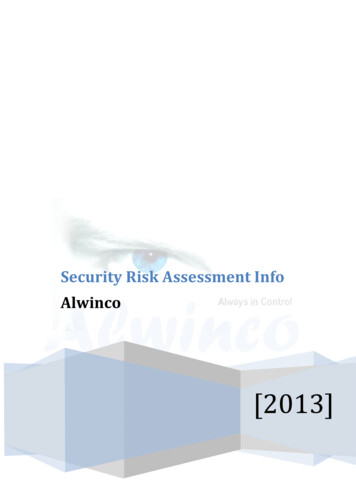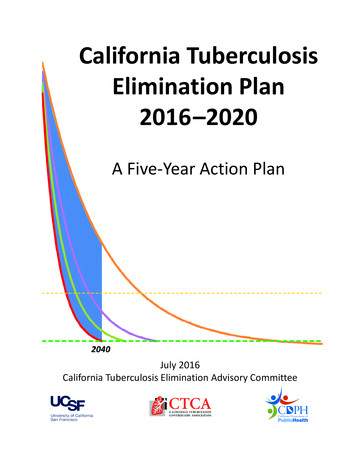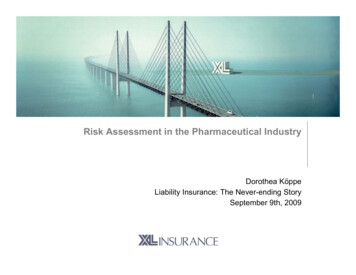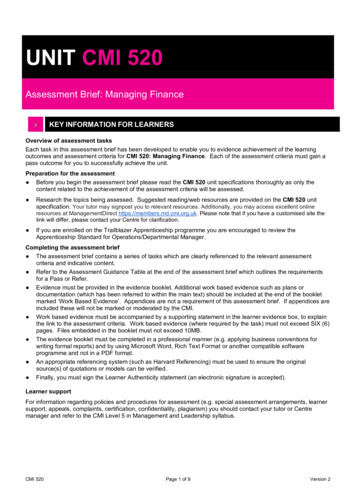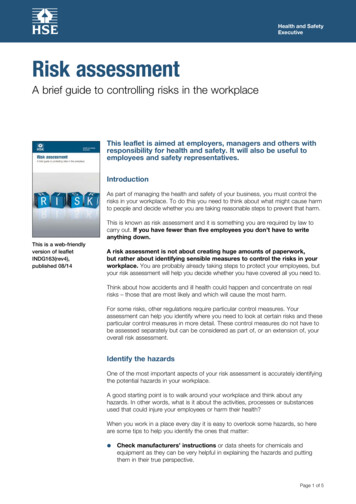
Transcription
Health and SafetyExecutiveRisk assessmentA brief guide to controlling risks in the workplaceThis leaflet is aimed at employers, managers and others withresponsibility for health and safety. It will also be useful toemployees and safety representatives.IntroductionAs part of managing the health and safety of your business, you must control therisks in your workplace. To do this you need to think about what might cause harmto people and decide whether you are taking reasonable steps to prevent that harm.This is known as risk assessment and it is something you are required by law tocarry out. If you have fewer than five employees you don’t have to writeanything down.This is a web-friendlyversion of leafletINDG163(rev4),published 08/14A risk assessment is not about creating huge amounts of paperwork,but rather about identifying sensible measures to control the risks in yourworkplace. You are probably already taking steps to protect your employees, butyour risk assessment will help you decide whether you have covered all you need to.Think about how accidents and ill health could happen and concentrate on realrisks – those that are most likely and which will cause the most harm.For some risks, other regulations require particular control measures. Yourassessment can help you identify where you need to look at certain risks and theseparticular control measures in more detail. These control measures do not have tobe assessed separately but can be considered as part of, or an extension of, youroverall risk assessment.Identify the hazardsOne of the most important aspects of your risk assessment is accurately identifyingthe potential hazards in your workplace.A good starting point is to walk around your workplace and think about anyhazards. In other words, what is it about the activities, processes or substancesused that could injure your employees or harm their health?When you work in a place every day it is easy to overlook some hazards, so hereare some tips to help you identify the ones that matter: Check manufacturers’ instructions or data sheets for chemicals andequipment as they can be very helpful in explaining the hazards and puttingthem in their true perspective.Page 1 of 5
Health and SafetyExecutive Look back at your accident and ill-health records – these often help toidentify the less obvious hazards.Take account of non-routine operations (eg maintenance, cleaningoperations or changes in production cycles).Remember to think about long-term hazards to health (eg high levels ofnoise or exposure to harmful substances).Visit the HSE website (www.hse.gov.uk) – HSE publishes practical guidanceon hazards and how to control them.There are some hazards with a recognised risk of harm, for example working atheight, working with chemicals, machinery, and asbestos. Depending on the typeof work you do, there may be other risks that are relevant to your business.Who might be harmed?Then think how employees (or others who may be present, such as contractors orvisitors) might be harmed. Ask your employees what they think the hazards are, asthey may notice things that are not obvious to you and may have some good ideason how to control the risks.For each hazard you need to be clear about who might be harmed – it will help youidentify the best way of controlling the risk. That doesn’t mean listing everyone byname, but rather identifying groups of people (eg people working in the storeroomor passers-by). Remember: Some workers may have particular requirements, eg new and young workers,migrant workers, new or expectant mothers, people with disabilities, temporaryworkers, contractors, homeworkers and lone workers (www.hse.gov.uk/toolbox/workers).Think about people who might not be in the workplace all the time, such asvisitors, contractors and maintenance workers.Take members of the public into account if they could be harmed by your workactivities.If you share a workplace with another business, consider how your work affectsothers and how their work affects you and your workers. Talk to each other andmake sure controls are in place.Ask your workers if there is anyone you may have missed.Evaluate the risksHaving identified the hazards, you then have to decide how likely it is that harm willoccur, ie the level of risk and what to do about it. Risk is a part of everyday life andyou are not expected to eliminate all risks. What you must do is make sure youknow about the main risks and the things you need to do to manage themresponsibly.Generally, you need to do everything ‘reasonably practicable’ to protect peoplefrom harm. This means balancing the level of risk against the measures needed tocontrol the real risk in terms of money, time or trouble. However, you do not needto take action if it would be grossly disproportionate to the level of risk.Your risk assessment should only include what you could reasonably be expectedto know – you are not expected to anticipate unforeseeable risks.Risk assessment: A brief guide to controlling risks in the workplacePage 2 of 5
Health and SafetyExecutiveLook at what you’re already doing and the control measures you already have inplace. Ask yourself: Can I get rid of the hazard altogether?If not, how can I control the risks so that harm is unlikely?Some practical steps you could take include: trying a less risky option;preventing access to the hazards;organising your work to reduce exposure to the hazard;issuing protective equipment;providing welfare facilities such as first aid and washing facilities;involving and consulting with workers.Improving health and safety need not cost a lot. For instance, placing a mirror on ablind corner to help prevent vehicle accidents is a low-cost precaution, consideringthe risks. Failure to take simple precautions can cost you a lot more if an accidentdoes happen.Involve your workers, so you can be sure that what you propose to do will work inpractice and won’t introduce any new hazards (www.hse.gov.uk/involvement).If you control a number of similar workplaces containing similar activities, you canproduce a model risk assessment reflecting the common hazards and risksassociated with these activities.You may also come across model assessments developed by trade associations,employers’ bodies or other organisations concerned with a particular activity. Youmay decide to apply these model assessments at each workplace, but you canonly do so if you: satisfy yourself that the model assessment is appropriate to your type of work;adapt the model to the detail of your own work situations, including anyextension necessary to cover hazards and risks not referred to in the model.Record your significant findingsMake a record of your significant findings – the hazards, how people might beharmed by them and what you have in place to control the risks. Any recordproduced should be simple and focused on controls.If you have fewer than five employees you don’t have to write anythingdown. But it is useful to do this so you can review it at a later date, for example ifsomething changes. If you have five or more employees you are required by law towrite it down.Any paperwork you produce should help you to communicate and manage therisks in your business. For most people this does not need to be a big exercise –just note the main points down about the significant risks and what you concluded.An easy way to record your findings is to use our risk assessment template(www.hse.gov.uk/risk).When writing down your results keep it simple, for example ‘fume from welding –local exhaust ventilation used and regularly checked’.Risk assessment: A brief guide to controlling risks in the workplacePage 3 of 5
Health and SafetyExecutiveA risk assessment must be suitable and sufficient, ie it should show that: a proper check was made;you asked who might be affected;you dealt with all the obvious significant hazards, taking into account thenumber of people who could be involved;the precautions are reasonable, and the remaining risk is low;you involved your employees or their representatives in the process.Where the nature of your work changes fairly frequently or the workplace changesand develops (eg a construction site), or where your workers move from site to site,your risk assessment may have to concentrate more on a broad range of risks thatcan be anticipated.Take a look at the selection of example risk assessments on HSE’s website(www.hse.gov.uk/risk). They show you what a completed risk assessment mightlook like for your type of workplace. You can use these as a guide when doingyour own.The site also has online risk assessment tools, to help employers complete andprint off their own records.If your risk assessment identifies a number of hazards, you need to put them inorder of importance and address the most serious risks first.Identify long-term solutions for the risks with the biggest consequences, as well asthose risks most likely to cause accidents or ill health. You should also establishwhether there are improvements that can be implemented quickly, eventemporarily, until more reliable controls can be put in place.Remember, the greater the hazard the more robust and reliable the measures tocontrol the risk of an injury occurring will need to be.Regularly review your risk assessmentFew workplaces stay the same. Sooner or later, you will bring in new equipment,substances and procedures that could lead to new hazards. So it makes sense toreview what you are doing on an ongoing basis, look at your risk assessment againand ask yourself: Have there been any significant changes?Are there improvements you still need to make?Have your workers spotted a problem?Have you learnt anything from accidents or near misses?Make sure your risk assessment stays up to date.Risk assessment: A brief guide to controlling risks in the workplacePage 4 of 5
Health and SafetyExecutiveFind out moreHSE’s risk management pages (including templates, as well as risk assessmenttools and examples): www.hse.gov.uk/riskHealth and safety made simple: The basics for your business Leaflet INDG449 HSEBooks 2011 www.hse.gov.uk/pubns/indg449.htm Microsite: www.hse.gov.uk/simple-health-safetyThe health and safety toolbox: How to reduce risks at work HSG268 HSE Books2014 ISBN 978 0 7176 6587 7 www.hse.gov.uk/pubns/books/hsg268.htmMicrosite: www.hse.gov.uk/toolboxFurther informationFor information about health and safety, or to report inconsistencies or inaccuraciesin this guidance, visit www.hse.gov.uk. You can view HSE guidance online andorder priced publications from the website. HSE priced publications are alsoavailable from bookshops.This guidance is issued by the Health and Safety Executive. Following the guidanceis not compulsory, unless specifically stated, and you are free to take other action.But if you do follow the guidance you will normally be doing enough to comply withthe law. Health and safety inspectors seek to secure compliance with the law andmay refer to this guidance.This leaflet is available at www.hse.gov.uk/pubns/indg163.htm. Crown copyright If you wish to reuse this informationvisit www.hse.gov.uk/copyright.htm for details.First published 08/14.Published by the Health and Safety Executive08/14INDG163(rev4)Page 5 of 5
Health and Safety Executive Risk assessment: A brief guide to controlling risks in the workplace Page 2 of 5 Look back at your accident and ill-health records - these often help to identify the less obvious hazards.





